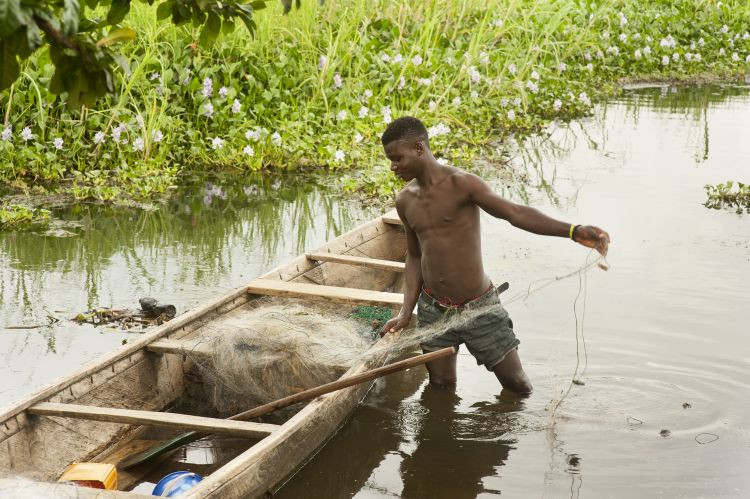OUTCOME STORY
Measuring environmental
flows at global and
regional scales
It’s all about balance and trade-offs. Natural ecosystems need water to survive and thrive, but people are dependent on ecosystems and water for agriculture, drinking and many other purposes. When water resources are limited, how do you make these resources available to communities while protecting biodiversity and the environment at the same time?
IWMI is pioneering new approaches to determining environmental flows (e-flows). E-flows are the quantity, timing and quality of water flows required to sustain freshwater and estuarine ecosystems and the human livelihoods and well-being that depend on these ecosystems. E-flows seek to strike a balance between water resources development and the protection of freshwater-dependent ecosystems. They tell us how much water we can use and how much we need to leave in the ecosystems.
The Global Environmental Flow Information System
 Recognizing the importance of e-flows, the United Nations created Indicator 6.4.2 of the Sustainable Development Goals (SDGs) to track how much freshwater is being withdrawn by all economic activities, compared to the total renewable freshwater resources available. Indicator 6.4.2 is a measure of water stress at national level. It takes into account e-flow requirements as a measure of how much water should be left in ecosystems.
Recognizing the importance of e-flows, the United Nations created Indicator 6.4.2 of the Sustainable Development Goals (SDGs) to track how much freshwater is being withdrawn by all economic activities, compared to the total renewable freshwater resources available. Indicator 6.4.2 is a measure of water stress at national level. It takes into account e-flow requirements as a measure of how much water should be left in ecosystems.
IWMI developed an online, publicly available, interactive tool called the ‘Global Environmental Flow Information System (GEFIS)’. The Food and Agriculture Organization of the United Nations (FAO) adopted GEFIS as the official global tool so that countries can insert the e-flow estimations into the water stress formula within the framework of the SDG.
In 2021, IWMI and FAO published a guideline on how to make use of GEFIS for SDG reporting. IWMI has now drafted two more reports which will substantially assist FAO in their use of GEFIS for SDG reporting. One report provides guidance on the measurement of the Environmental Management Class, making e-flows locally reflective of environmental conditions, while the other report deals with the contribution of groundwater to e-flows.
From global to regional
GEFIS is a valuable tool at a global level, but needs to be paired with tools that take into consideration local nuances and accurately incorporate local ecological conditions, making the estimation of e-flows much more meaningful.
As part of the Resilient Waters project, funded by the United States Agency for International Development (USAID), IWMI is working with partners in the Limpopo River Basin of Southern Africa to provide the necessary data to secure e-flows. The project is helping to provide a framework that will enable communities and ecosystems become more resilient to changes in streamflow.
The rural communities of the Limpopo River Basin are highly vulnerable to any adverse impacts caused by climate change and excessive upstream water use. The basin has a high diversity of endemic and unique aquatic biota and important ecosystem processes that help to support more than 14 million people who live in the basin and depend on its resources. The water resources of the basin are limited and overused.
IWMI scientists and partners conducted a risk assessment for the basin using the PROBFLO method, a holistic e-flow assessment tool that incorporates regional-scale ecological risk assessment methods in a robust, tested approach to determine e-flows with high confidence. It helps scientists evaluate the social and ecological consequences of altered flows at multiple spatial scales.
The IWMI team described the relationship between river flows and the river ecosystem, and quantified the flows necessary to keep the ecosystem in its present or better condition. The study found that the percentages of total water required to protect e-flows vary considerably, ranging from 49% in some of the smaller upstream tributaries to only 16% in the lower reaches of the river.
The IWMI team also highlighted the risk to ecosystem services provided by the basin when flows are altered. If e-flows were implemented, the condition of the river would be significantly improved, even though the overall e-flow is substantially less than the total present-day flow. Timing is key as e-flows can contribute to flows during the dry season when, at present, the river stops flowing in many places due to upstream abstractions. As a result, the risks to users of the ecosystem would be reduced in many parts of the basin. Local vulnerable communities would benefit from e-flows and be more resilient to climate shocks.
Researchers acknowledge that there are socioeconomic costs associated with the implementation of e-flows in the Limpopo River Basin. However, the multiple benefits, and the long-term costs of operating the system in an unsustainable state, will outweigh any immediate costs of protecting the ecosystem.
